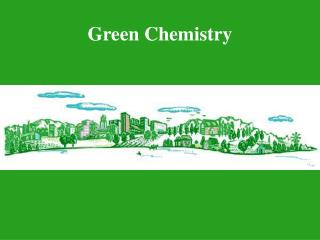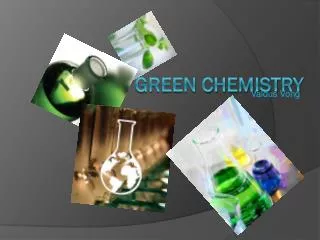

Green Chemistry
Jul 11, 2012
2.63k likes | 8.3k Views
Green Chemistry. GREEN CHEMISTRY. DEFINITION Green Chemistry is the utilisation of a set of principles that reduces or eliminates the use or generation of hazardous substances in the design, manufacture and application of chemical products . GREEN CHEMISTRY IS ABOUT
Share Presentation
- completely free
- famous example
- stirring distillation compression pumping
- solvents separation
- greatest strengths
- reduced hazard


Presentation Transcript
GREEN CHEMISTRY DEFINITION Green Chemistry is the utilisation of a set of principles that reduces or eliminates the use or generation of hazardous substances in the design, manufacture and application of chemical products . GREEN CHEMISTRY IS ABOUT • Waste Minimisation at Source • Use of Catalysts in place of Reagents • Using Non-Toxic Reagents • Use of Renewable Resources • Improved Atom Efficiency • Use of Solvent Free or Recyclable Environmentally Benign Solvent systems
Green Chemistry Is About... Waste Materials Hazard Reducing Risk Energy Cost
Why do we need Green Chemistry ? • Chemistry is undeniably a very prominent part of our daily lives. • Chemical developments also bring new environmental problems and harmful unexpected side effects, which result in the need for ‘greener’ chemical products. • A famous example is the pesticide DDT.
Green chemistry looks at pollution prevention on the molecular scale and is an extremely important area of Chemistry due to the importance of Chemistry in our world today and the implications it can show on our environment. • The Green Chemistry program supports the invention of more environmentally friendly chemical processes which reduce or even eliminate the generation of hazardous substances. • This program works very closely with the twelve principles of Green Chemistry.
The 12 Principles of Green Chemistry (1-6)
The 12 Principles of Green Chemistry (7-12) • 7 Use of Renewable Feedstocks • A raw material or feedstock should be renewable rather than depleting whenever technically and economically practicable. • 8 Reduce Derivatives • Unnecessary derivatization (use of blocking groups, protection/de-protection, and temporary modification of physical/chemical processes) should be minimised or avoided if possible, because such steps require additional reagents and can generate waste. • 9 Catalysis • Catalytic reagents (as selective as possible) are superior to stoichiometric reagents. • 10 Design for Degradation • Chemical products should be designed so that at the end of their function they break down into innocuous degradation products and do not persist in the environment. • 11 Real-time Analysis for Pollution Prevention • Analytical methodologies need to be further developed to allow for real-time, in-process monitoring and control prior to the formation of hazardous substances. • 12 Inherently Safer Chemistry for Accident Prevention • Substances and the form of a substance used in a chemical process should be chosen to minimise the potential for chemical accidents, including releases, explosions, and fires.
“It is better to prevent waste than to treat or cleanup waste after it is formed” Chemical Process
“The use of auxiliary substances (e.g. solvents,separation agents, etc.) should be made unnecessarywherever possible, and innocuous when used”
“Energy requirements should be recognized for their environmental impacts and should be minimized.Synthetic methods should be conducted at ambientpressure and temperature”
GLOBAL WARMING Heating Cooling Stirring Distillation Compression Pumping Separation Energy Requirement (electricity) Burn fossil fuel CO2 to atmosphere
“A raw material of feedstock should be renewablerather than depleting wherever technically andeconomically practical” Non-renewable Renewable
Resource Depletion • Renewable resources can be made increasingly viable technologically and economically through green chemistry. Carbondioxide Biomass Nanoscience Solar Waste utilization
Poly lactic acid (PLA) for plastics production
Polyhydroxyalkanoates (PHA’s)
The major uses of GREEN CHEMISTRY • Energy • Global Change • Resource Depletion • Food Supply • Toxics in the Environment
Energy • The vast majority of the energy generated in the world today is from non-renewable sources that damage the environment. • Carbon dioxide • Depletion of Ozone layer • Effects of mining, drilling, etc • Toxics
Energy • Green Chemistry will be essential in • developing the alternatives for energy generation (photovoltaics, hydrogen, fuel cells, biobased fuels, etc.) as well as • continue the path toward energy efficiency with catalysis and product design at the forefront.
Global Change • Concerns for climate change, oceanic temperature, stratospheric chemistry and global distillation can be addressed through the development and implementation of green chemistry technologies.
Resource Depletion • Due to the over utilization of non-renewable resources, natural resources are being depleted at an unsustainable rate. • Fossil fuels are a central issue.
Resource Depletion • Renewable resources can be made increasingly viable technologically and economically through green chemistry. • Biomass • Nanoscience & technology • Solar • Carbon dioxide • Chitin • Waste utilization
Food Supply • While current food levels are sufficient, distribution is inadequate • Agricultural methods are unsustainable • Future food production intensity is needed. • Green chemistry can address many food supply issues
Food Supply • Green chemistry is developing: • Pesticides which only affect target organisms and degrade to innocuous by-products. • Fertilizers and fertilizer adjuvants that are designed to minimize usage while maximizing effectiveness. • Methods of using agricultural wastes for beneficial and profitable uses.
Toxics in the Environment • Substances that are toxic to humans, the biosphere and all that sustains it, are currently still being released at a cost of life, health and sustainability. • One of green chemistry’s greatest strengths is the ability to design for reduced hazard.
Pollution Prevention Hierarchy Prevention & Reduction Recycling & Reuse Increasing Greenness Treatment Disposal
Conclusion Green chemistryNot a solution to all environmental problems But the most fundamental approach to preventing pollution.
This powerpoint was kindly donated to www.worldofteaching.com http://www.worldofteaching.com is home to over a thousand powerpoints submitted by teachers. This is a completely free site and requires no registration. Please visit and I hope it will help in your teaching.
- More by User

Green Chemistry. Sponsored by:. “ Chemistry has an important role to play in achieving a sustainable civilization on earth.” — Dr. Terry Collins, Professor of Chemistry Carnegie Mellon University. Definition.
2.28k views • 25 slides

Green Chemistry. By Dr. Kandikere Ramaiah Prabhu Principal Research Scientist Department of Organic Chemistry Indian Institute of Science Bangalore – 560 012. October 23, 2010, Bangalore. History….. Green Chemistry is born around 199o What is green chemistry or Sustainable Technology
1.85k views • 55 slides

GREEN CHEMISTRY
GREEN CHEMISTRY Presentation Courtesy of the American Chemical Society. GREEN CHEMISTRY . PREVENTING POLLUTION SUSTAINING THE EARTH. 1.
1.77k views • 30 slides

Green Chemistry. TRUE OR FALSE?. TRUE OR FALSE?. Sustainability is:- Development which meets the needs of people today without worrying how future generations can meet their needs. TRUE OR FALSE?. Natural gas is a renewable feedstock. TRUE OR FALSE?. TRUE OR FALSE?.
603 views • 21 slides

Green Chemistry.
Green Chemistry. By Thong N. Green Chemistry, what is it?.
379 views • 11 slides

Green Chemistry . By Emmie Guy 10 Orange. What is meant by the term green chemistry?. The term Green Chemistry relates to creating new products, chemicals and procedures to have a positive impact on our environment in order to take care of the world we live in by preventing pollution.
762 views • 9 slides

GREEN CHEMISTRY. ARAVIND ES CE13M022. INTRODUCTION. Green chemistry, also called sustainable chemistry
11.57k views • 17 slides

Green Chemistry. Rhiannon Bennett. Green Chemistry follows a set of 12 Principles in order to avoid the use or generation of hazardous substances. It is used in industrial production to prevent pollution and to minimise effect on the environment. What is green chemistry?.
728 views • 6 slides

Green Chemistry. By Akrem Abdul. What is Green Chemistry?.
576 views • 10 slides

Green Chemistry. By Jeremy Dolphin. What is Green Chemistry?. Green chemistry is a branch of chemistry that focuses on more environmentally safe production and use of chemicals and reactions. . The twelve principles of green chemistry.
693 views • 9 slides

Green Chemistry. Teacher Enhancement Workshop. Kamehameha High School, Oahu, Hawai’i. Presented by Marv Lang, Don Showalter & Gary Shulfer University of Wisconsin-Stevens Point, USA Presentation constructed by Angela Burmeister University of Wisconsin – Stevens Point, USA.
1.12k views • 15 slides

Green Chemistry. Green Chemistry. Professor Hector R Rodriguez School of Business Mount Ida College. Society The Corporation and Its Stakeholders People for the Ethical Treatment of Animals Corporate Citizenship The Social Responsibility of Business The Shareholder Primacy Norm
828 views • 16 slides

Green Chemistry. Daniel van der Linden. Green Chemistry. 1. Explain what is meant by the concept of “ Green Chemistry ”? Green Chemistry is designing chemical products that reduce eliminate and hazardous substances. Therefore causing less damage to environment and humans.
538 views • 5 slides

Green Chemistry. By Rebecca Gill. What is Green Chemistry?.
493 views • 7 slides

GREEN CHEMISTRY. What is it? • encourages environmentally conscious behaviour • reduces and prevents pollution • reduces the destruction of the planet. GREEN CHEMISTRY. What is it? • encourages environmentally conscious behaviour • reduces and prevents pollution
714 views • 27 slides

Green Chemistry. Dr. C. H. GILL. (Prof. & Head) Dept. of Chemistry, Dr. Babasaheb Ambedkar Marathwada University, Aurangabad. [email protected]. GREEN CHEMISTRY. GREEN CHEMISTRY. PREVENTING POLLUTION SUSTAINING THE EARTH. What is Green Chemistry?.
4.95k views • 65 slides

Valdus Vong. GREEN CHEMISTRY. Green Chemistry. ‘Green Chemistry’ is essentially a way of thinking rather than a new branch of chemistry and is about utilising a set of principles that seek to reduce the environmental impact of chemical
744 views • 10 slides

Green Chemistry. Milan Sanader Author, Nelson Chemistry. GREEN CHEMISTRY INVOLVES…. Reducing or eliminating the use or production of hazardous substances in the manufacture of chemical products Considering the hazards of reagents as well as their properties. A GREEN CHEMICAL PROCESS IS.
750 views • 16 slides

Green Chemistry. By Courtney Smith 10 Orange. What Is Green Chemistry??. Green chemistry is a design and process of safer chemicals to eliminate the use of hazardous substances. Green chemistry relies on 12 principles that are used to re-design or design molecules. 12 Principles.
779 views • 7 slides

Green Chemistry. By Thong N. Principle 4: Use Renewable Feedstock. Use raw materials and feedstock that are renewable rather than depleting.
482 views • 10 slides

870 views • 15 slides

Green Chemistry. Production of Ibuprofen. 7S Fan Kai Hei (10) 7S Kwok Kai Ching (11) 7S Tang Yuet Chi (24). Introduction. Anti-inflammatory drug Two ways of synthesis: Boot’s synthesis and Green synthesis Structure of Ibuprofen:. Green chemistry.
295 views • 22 slides

IMAGES
COMMENTS
Green chemistry aims to reduce hazardous waste and pollution through principles like preventing waste, using renewable resources, safer solvents and feedstocks, and designing chemicals and processes to be less toxic and hazardous.
This document discusses green chemistry and its 12 principles. Green chemistry is defined as the design of chemical products and processes that reduce or eliminate the use or generation of hazardous substances. Its goals are pollution prevention, reducing waste and use of energy.
Green chemistry is the design of chemical products and processes that reduce or eliminate the use and generation of hazardous substances. The 12 principles of green chemistry include using renewable resources, designing safer chemicals, and using catalysis to make reactions more efficient.
What Is Green Chemistry? Green chemistry is the design of chemical products and processes that reduce or eliminate the use and generation of hazardous substances.
The Green Evolution: Sustainable Chemistry in Global Scholarly Education Presentation slides are available now! The edited recording will be made available as soon as possible.
Green chemistry is described as designing chemical products and processes to reduce hazardous substances. The 12 principles of green chemistry are then outlined, which include preventing waste, designing safer chemicals, using renewable feedstocks, and designing for energy efficiency and catalysis.
Green Chemistry • Green Chemistry is the design of chemical products and processes that reduce or eliminate the use and/or generation of hazardous substances. Historical Approach to Environmental Problems • Waste treatment, control, and disposal; pollutant monitoring; hazardous waste site cleanup.
Green chemistry aims to reduce or eliminate the use of hazardous substances in chemical products and processes. It promotes principles like waste minimization, use of renewable resources, and improved atom efficiency.
Green chemistry is the design of chemical products and processes that reduce or eliminate the use and generation of hazardous substances. The 12 principles of green chemistry include using renewable resources, designing safer chemicals, and using catalysis to make reactions more efficient.
GREEN CHEMISTRY IS ABOUT • Waste Minimisation at Source • Use of Catalysts in place of Reagents • Using Non-Toxic Reagents • Use of Renewable Resources • Improved Atom Efficiency • Use of Solvent Free or Recyclable Environmentally Benign Solvent systems.